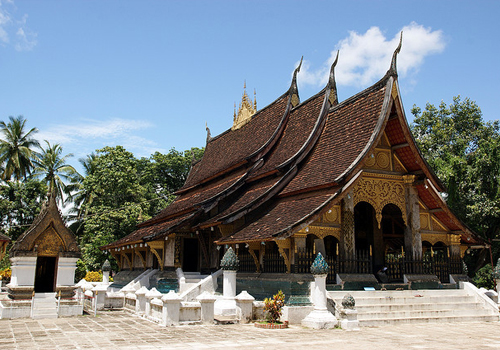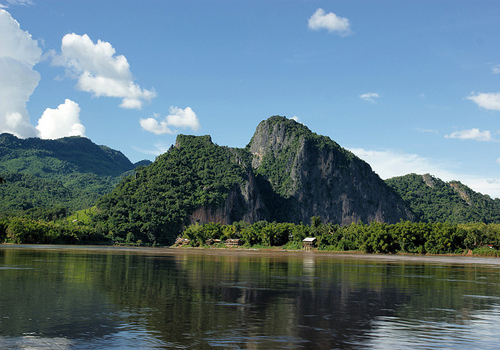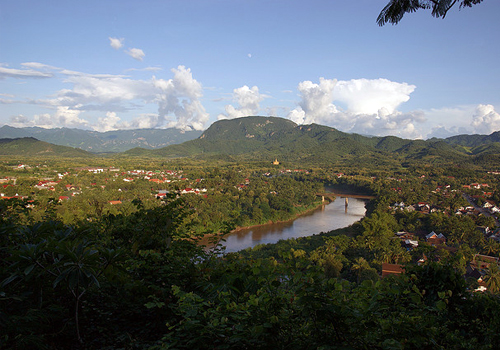Luang Prabang Travel Guide
Royal Palace (Haw Kham)
Address: Luang Prabang
The former Royal Palace, a mixture of French and Lao architecture, is now a museum preserving the possessions of the monarchy and has one of the most golden and glitzy interiors around. Above the entrance is a three-headed elephant sheltered by the sacred white parasol, the symbol of the Lao monarchy. The most impressive room is the Throne Hall, a dazzling interior of mosaics and mirrors, with displays of royal regalia including glittering swords and the former King's own elephant saddle. The museum's most prized possession, the Pha Bang, a golden image of the Buddha, is housed in a small barred room that was the King's personal shrine. It is the most sacred image in the country, believed to have been crafted in the heavens, and containing miraculous powers of protection over the country. The museum has information in Lao and English but it is worth visiting with a local guide to really bring the place to life and hear all about the myths and legends as well as the history. Shoes and bags must be left at the entrance (there are lockers) and, despite the many images which have made their way onto tourist review sites, photography is not allowed.<br /><br />
Wat Xieng Thong (Golden City Temple)
Address: Luang Prabang
The most enchanting monastery in the country, and probably its most talked-about tourist attraction, is the magnificent Golden City Temple at the tip of Laos' peninsula. The graceful, sweeping tiled roof of the main temple is its most impressive feature and the walls are decorated with stencilled gold designs depicting many different traditional tales. At the rear, there is a splendid coloured glass mosaic illustrating the 'tree of life'. In the peaceful atmosphere of the compound garden are several shelters, housing rare Buddha images and the gilded royal funerary carriage. It is possible to visit too many temples in Laos and get tired of them as a result, as many of them are very similar. It is best to visit only a few and only the best. General consensus is that if one only explores one temple in Laos it should be Wat Xieng Thong. Bring a guide book or hire a local guide in order to appreciate the temple and its history fully. In the evening, the light reflects beautifully off the glass and gold of the walls and the monks are called in to prayer by drums.<br /><br />
Plain of Jars (Phonsavan)
Address: Luang Prabang
The mysterious Plain of Jars in the Xiang Khouang province is an unusual sight, and a must-visit tourist attraction for travellers to Luang Prabang. Hundreds of huge solid stone jars lie scattered about the landscape, some weighing up to six tonnes and measuring about six feet (2m) in length. They are believed to be over 2,000 years old, although their origin and function is unknown. Numerous theories and legends have been fashioned - one such legend states that they were made to ferment rice wine to celebrate a victorious battle against a wicked chieftain in the 6th Century; while other theories claim they were used as sarcophagi, or funerary urns. They are divided into five major groups, with Thong Hai, or Site 1, the largest and most easily accessible site. The jars lie amid thousands of unexploded mines left behind by the war, and as a result only Sites 1, 2 and 3 are open to visitors; the rest are considered too dangerous, and visitors should heed warning signs and keep to well-worn paths. Many guesthouses in the town of Phonsavan offer tours to the sites. While you're in Phonsavan be sure to visit the Mines Advisory Group (MAG) to learn about the clearing of unexploded bombs in the area and throughout Laos.<br /><br /> The site is situated several kilometres southeast of Phonsavan, a 30-minute flight from Luang Prabang. Those interested in visiting can either hire a 4X4 or a small tuk-tuk for the day, with a driver/guide; or, for the adventurous, it is possible to hire a motorbike and drive out to the sites. Sites 1 and 2 are well signposted and the third one is easy to find if paying attention. The drive out to the sites is scenic and the people living along the road are generally friendly and helpful.<br /><br />
Pak Ou Caves
Address: Luang Prabang
About two hours by boat from Luang Prabang lie the Pak Ou Caves, which are only accessible from the water. This attraction has visitors rather divided: some find it an intriguing place of spiritual power and others don't understand what the fuss is about. Most agree, however, that the scenic boat trip to reach the caves is fun and worthwhile. Lower and upper caves contain an impressive collection of mostly wooden Buddha statues assembled over the centuries by locals and pilgrims. Each year, hundreds of pilgrims come to these caves to add a statue to the growing collection. The assortment of Buddhas - some in hard to reach places - is very interesting and there are some quite unusual specimens on display; anyone interested in religious icons will find the place fascinating. The upper cave (Tham Theung) is reached by means of a flight of stairs and requires the use of a flashlight, while the lower cave (Tham Thing) is visible from the river. If visitors want to explore the more mysterious upper cave then they should be sure to bring their own torch, or money to buy one at the entrance. Photos are permitted and candles can be lit as a tribute. The trip to the caves is often combined with visits to villages on the river banks or activities like elephant riding.<br /><br />
Kuang Si Falls
Address: Luang Prabang
Admission: A small fee of about $2 is sometimes asked of visitors.
Frequently the top-rated attraction in Luang Prabang according to tourists, the beautiful multi-tiered Kuang Si Falls are worth a trip for their refreshing beauty and serenity. Turquoise-green water tumbles over a series of limestone terraces and collects in lovely pools that are surrounded by lush greenery. Walkways lead around the base and to the summit, about 200 feet (61m) up, and there are numerous places to picnic. There are also things like rope swings, branches and rocks to jump off and the swimming is glorious so be sure to bring your swimwear. It is best to get to the falls as early as possible before the crowds arrive to really appreciate the natural splendour and get good photographs. The falls are about 18 miles (29km) south of Luang Prabang.<br /><br /> <br /><br />
Phou Si
Address: Luang Prabang
Phou Si is a hill near the confluence of the Mekong and Khan rivers, filled with temples. It is visible all over town and as such acts as a navigation landmark for visitors. The views of Luang Prabhang from the top of the hill are worth the steep walk of 355 individual steps. The lower slopes of the hill are dotted with the city's oldest temples, but the best is the golden stupa of That Chomsi at the top, built in 1804. Visit this wonderful attraction in the early morning, when it is cool and the temples are at their most active, or in the evening for the epic sunsets. Note, however, that sunset is the most popular time to climb the hill and during the peak tourism season it gets very crowded. Those wanting to experience the beauty and serenity of the place without the crowds should visit in the early morning. The climb is a bit easier from the back of the hill, where a trail winds gradually upwards and there are only about a hundred steps to master, as opposed to 300-odd! Some of the most interesting Buddha statues can be found via this back entrance. It's ideal to climb up one way and down the other so that all the views and sights can be appreciated. There is a night market in the road in front of the Old Palace, at the foot of Phou Si, which is worth strolling around if visiting in the evening.<br /><br />
Buddhas Birthday
Where: Nationwide,Luang Prabang
When: First full moon in May
The biggest annual event on the Buddhist calendar is Visakha Busa, the day on which the Buddha was born, died and became enlightened. Temples are filled with devotees, and families hold feasts and parties to mark the occasion. Although the festival is marked in every village in the country, the best place to experience it is probably Luang Prabang, where a magical lantern procession is held to mark the occasion, as well as ceremonies at the sacred Pak Ou Caves, a little further up the river. Travellers in Vientiane will enjoy fireworks and bamboo rockets, most of which are home-made with gunpowder - so don't get too close! The festival is a joyous celebration of faith and there is nothing sombre about the occasion, making it an extremely fun time to be in the country. The Lao people tend to be friendly and enjoy sharing their festivities with respectful tourists who show an interest in their traditions. Note that although many countries celebrate Buddha's birthday - including China, Japan, Vietnam, Thailand, Sri Lanka and many more - the dates on which the day is celebrated often vary country to country. The festival takes place on the day of the first full moon in May in Laos, except in leap years.<br /><br />
Luang Prabang Alms Ceremony
Where: ,Luang Prabang
When: Sunrise daily
One of the main attractions in Luang Prabang is the morning Alms Ceremony. Male Laotians from across the country come to Luang Prabang to study Buddhism for at least a year at some point in their life. As such the city is teeming with men and boys dressed in their saffron-coloured robes. Every morning before sunrise the monks proceed through the village along the main street collecting alms for their consumption for the day ahead. This ancient and ritualised ceremony is a sight to behold and a great photo opportunity for those willing to wake up before dawn to go out and see it. Tourists are able to buy rice and foods to give to the monks. Be sure to buy fresh food as there have been scams in the past where market vendors sell old or stale leftovers to naïve tourists. Remember, the ceremony is a serious and holy event. Onlookers should be respectful at all times, particularly if when taking pictures. Women should dress conservatively and it is considered extremely rude to come into physical contact with a monk, more so for women than men. The procession is a solemn and silent affair which is sometimes embarrassingly ruined by ignorant or pushy tourists.<br /><br />
(Data provided outside US and Canada by Foreca, Data provided for US and Canada by WDT)
| Jan | Feb | Mar | Apr | May | Jun | Jul | Aug | Sep | Oct | Nov | Dec | |
| Average High | 27° | 31° | 33° | 35° | 35° | 33° | 32° | 32° | 32° | 31° | 29° | 27° |
| Average Low | 13° | 14° | 17° | 20° | 23° | 26° | 28° | 29° | 26° | 22° | 18° | 15° |
(Data provided outside US and Canada by Foreca, Data provided for US and Canada by WDT)
| Jan | Feb | Mar | Apr | May | Jun | Jul | Aug | Sep | Oct | Nov | Dec | |
| Average High | 82° | 89° | 93° | 96° | 95° | 93° | 90° | 90° | 91° | 89° | 85° | 81° |
| Average Low | 56° | 58° | 63° | 69° | 73° | 74° | 74° | 74° | 73° | 69° | 64° | 59° |


